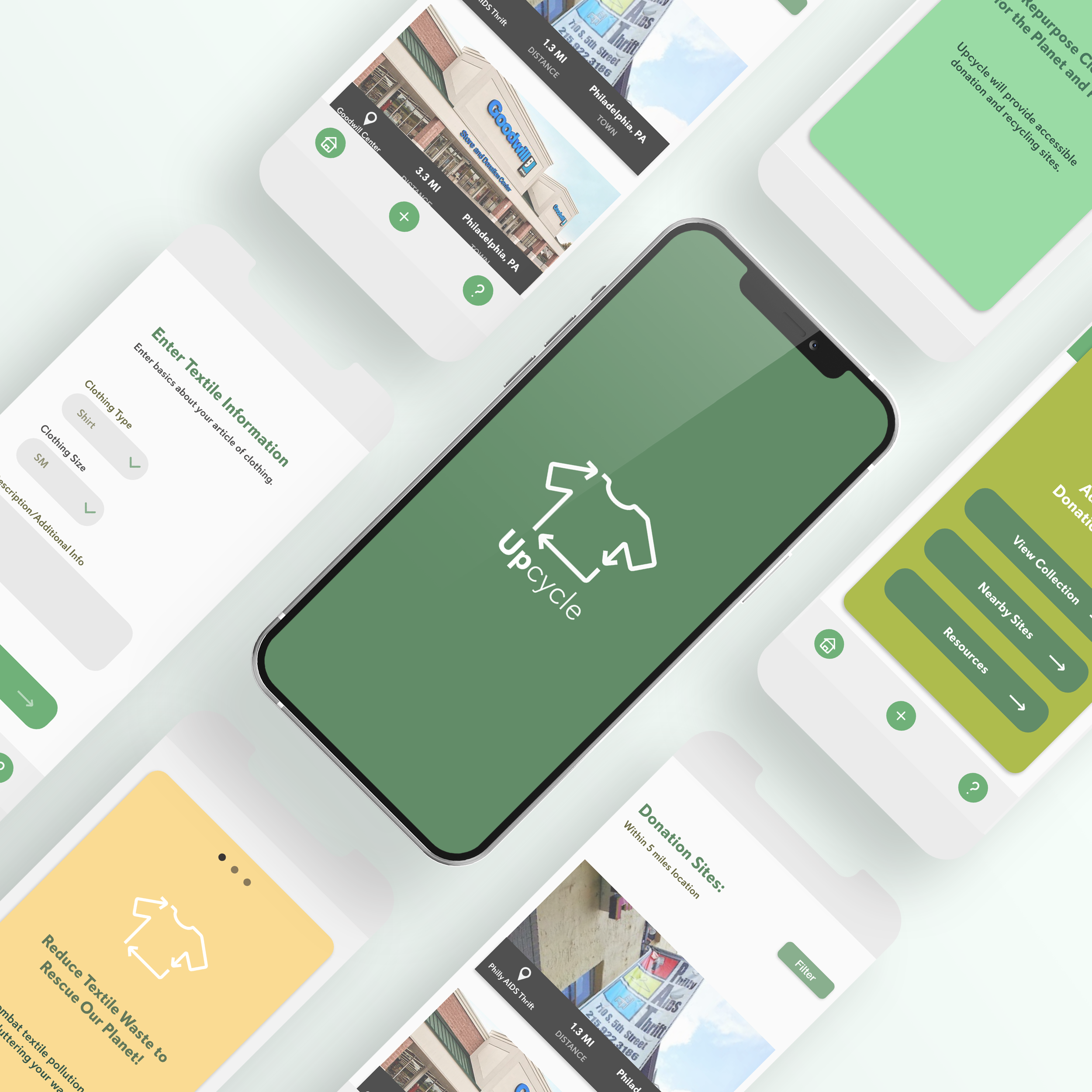Upcycle
Brand Identity & UX Design for App
Overview:
Reduce textile pollution and renovate your wardrobe.
The goal of this project was to create an app meant to declutter or organize. This process included concepting, naming, designing the brand identity, and the way users interact with this app. Ultimately, this app focused on fulfilling the needs of a set audience with the design and functionality.
Role: Research, UI, UX Design
Art Direction: Jennifer Kowalski
GOAL
Design a strong and consistent brand that is inventive, memorable, and adaptable with compelling hierarchy that communicates to a specific audience.
UNDERSTANDING THE PROBLEM
The brand should be adaptive and designed to embrace a specific audience. I began this process by obtaining formative research on the target audiences. I gathered research about the sustainable retail industry’s competition and audience. With this, I identified underlying unmet needs of this audience and defined these with user-personas.
FORMATIVE RESEARCH
Collected areas of research regarding the competition, audience, and formative features of the sustainability retail industry. The research was framed in order to justify creative decisions to concept an ideal app. This enhanced understanding of factors that attract a diverse audience to this industry well as their pain-points.
INSIGHTS
User Demographic Research
Millennial and Gen-Z (18-24) are a strong force in sustainable retail.
Ethics and Morals Become Identity Markers For Brand.
Millennials expect more from brands with ethics and morality becoming part of their identity and culture in real life and online. The most important brand values identified by this group are:
Honesty at 77%
Reliability at 74%
Helping family at 74%
Compassion at 72%
Commitment at 72%
Convenience
Most millennials have grown up in a world that emphasizes convenience as a priority. Between fast food, video streaming, personalized social media feeds, and the ability to Google any question or concern in real-time, they’re more likely to think about everything in terms of how fast, efficient, and available it is. Businesses that recognize this desire are making it a priority to deliver convenience in fresh, creative ways.
Choices
Millennials are more likely to enjoy platforms that allow customization and personalization as opposed to privacy. Their pursuit of personalized, unique, and novel offerings has created a ripple effect throughout countless industries.
USER PERSONA DEVELOPMENT
The user personas were developed to embody needs and expectations of our target audiences and users through user-centered design.
From data collected from our research, these individuals were modeled after a variety of findings:
DESIGNING USER FLOWS
The User flow is a flowchart that visually shows the decisions that are be made as a user navigates an app.
This breaks down the process of entering uploading clothing details to the app, and getting useful resources as a result.
User-flow outlining each interaction with the app and the end result of user action.
DESIGNING WIREFRAME
Using Upcycle to renovate your wardrobe while reducing textile pollution. Before entering your profile information, the user learns an overview of Upcycle’s sustainability focused values and functionality. Not only can you organize your wardrobe by donating and recycling old clothes, but help the planet’s overwhelming pollution of the textile industry, and provide someone with a new article of clothing.
Some points in mind while developing this wireframe:
How to show the value of this app, and how to completely simplify this process for the user.
How are these categories organized? Once there is a "to donate" list what does the user do?
How can the app help the user through to the next step?
An early and interactive wireframe; click the square to use this prototype.
FINAL PROTOTYPE INSIGHTS
After a series of user-testing and revising, this interactive prototype is the final stage of design for an application or program before it is coded. Using InVision prototyping software, this shows how a user will navigate the process of using the app, and the interface in which they will do that. From the process of turning your App Concept into a fully-designed prototype, I experienced decisions and challenges affecting the design of the user experience and interface. Building from the wireframe, some adjustments made include:
Enhanced wireframe based on user-feedback to streamline the clothing data entry process.
Created categories, and implemented a process to find the nearest recycling/donation centers to the user.
Incorporated icons and color to help inform users how to use your app, along with complementing the minimalist style.
With the user flow in mind, applied these designs on top of the older wireframes.
Final prototype; interact with the screens by clicking the phone.
FINAL RESULTS
To enrich the brand, collateral and environmental design were incorporated into the brand.
This includes a promotional video, website, and various displays of the app,.









